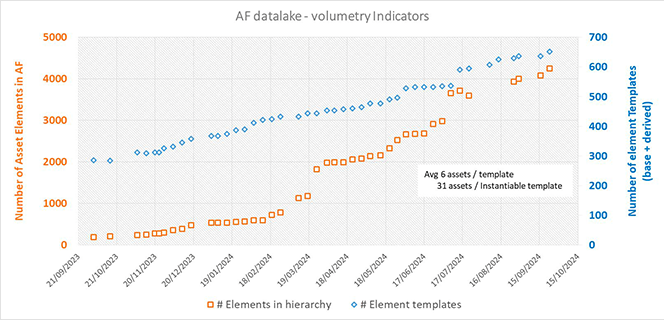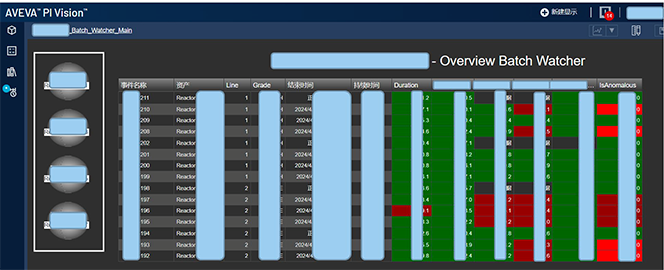Syensqo, a newly established multinational materials company originally a part of Solvay, has 30 plants in its polymers division alone. The company needed to optimize maintenance activities in a way that took into account each plant’s individual needs while allowing solutions to be replicated across them. So Syensqo used AVEVATM PI SystemTM as the core of its digital infrastructure to reduce maintenance costs, minimize batch duration variability, and replicate solutions four times faster.

“To make replicability possible from one site to another, we had to structure our data. . . We said we absolutely need a data foundation sufficiently well-structured, so we could replicate faster and increase the value we deliver.”
-- Antoine Roy, Industrial Digital Manager, GBU Specialty Polymers, Syensqo
Challenges
Enable rapid replication of digital solutions across its plants while meeting individual site needs
Maximize the value of centralized activities while still developing local initiatives and allowing sites to retain autonomy
Develop a digital ecosystem that delivers immediate value but also evolves and supports incremental use cases across plants
Results

reduction in maintenance costs in less than one year

reduction in OEE breakdown losses in less than one year

reduction in batch duration variability in just three months

Maintenance solution replication across plants is four times faster
A central-to-local approach: Collaboration across sites
Syensqo is a leading provider of high-performance polymers and thermoplastic composites, as well as battery materials, green hydrogen, renewable materials and biotechnology. It is composed of 13,000 people around the globe, spread across more than 60 sites and 12 research centers. Syensqo needed a strong data foundation to deliver value across its operational ecosystem.
Syensqo’s digital transformation journey started in 2016. The digital team was making progress on a site-by-site, problem-by-problem basis, but they came to the point when replicating solutions from one site to another required structuring their data. How could they standardize solutions by contextualizing and centralizing operations data—without ignoring the nuances of individual plant needs?
Part of the challenge of optimizing maintenance across Syensqo’s various sites was finding an approach that allowed them to replicate solutions across different plants quickly. But, as Antoine Roy, Industrial Digital Manager of GBU Specialty Polymers at Syensqo says, “None of our sites are producing the same product. They are different plants, different products. Therefore, we cannot just copy and paste.”
So Syensqo developed a central-to-local digital approach that includes central data management and local site data managers. The centralized team creates templates and asset hierarchies that are standardized to use across plants, while local teams—familiar with sites’ specific issues and challenges—build solutions based on the corporate templates for elements, assets, and events. This approach is more circular than a traditional top-down hierarchy, with local teams collaborating with central data managers to find solutions that meet local site needs but can serve multiple sites with minimum adjustment.
"When we said we wanted to replicate, we immediately understood there is a place for centralizing things. But at the same time, we absolutely need the dynamic and momentum of local teams and all their energy.”
– Antoine Roy, Industrial Digital Manager, GBU Specialty Polymers, Syensqo
AVEVA PI System adds structure and context to data
AVEVA PI System is key to Syensqo’s central-to-local digital approach, particularly AVEVA PI Server’s asset framework function. Real-time and historical data is collected from Syensqo’s production equipment via DCS and equipment sensors and then aggregated in AVEVA PI Server. There, AVEVA PI Server’s asset framework—which contains templates of assets as well as batch phases—adds structure and context to that data.
From AVEVA PI Server’s asset framework, this operational data flows into various tools and analytics platforms such as Seeq and Ekhosoft, with AVEVA PI Vision dashboards for Syensqo’s “batch watcher” and process anomaly detection. In the span of one year, Syensqo’s specialty polymer division went from 200 elements to over 4,000, with 600 templates and 60,000 data points in AVEVA PI Server’s data archive.
Using this architecture, central data managers and local teams, with input from process experts, co-construct solutions for different use cases. This collaboration strives to create solutions that are generic enough to be adapted to other contexts, and that can be easily replicated, give or take a few parameters. For example, one of Syensqo’s sites has hundreds of PCM pumps, and the local team wanted to monitor the wear of these pumps, so they needed a condition-based monitoring solution to detect when they should plan maintenance over a period of time.
The local site team collaborated with the central data team to create a solution that can be replicated across other sites. Condition-based monitoring for PCM pumps might not be a priority for another site that only has a few of these pumps, but it is now low-hanging fruit—it can be built with already-created templates. In this way, all sites can solve for their own priorities, but the solutions they find can be used by other sites. Since not all sites can work on all their challenges or issues at once, this approach allows each site to tackle its primary issues while also taking advantage of others’ solutions. This creates a true digital culture because everyone is involved in the process.
 In the span of one year, Syensqo’s specialty polymer division went from 200 elements to over 4,000, with 600 templates and 60,000 data points in AVEVA PI Server’s data archive.
In the span of one year, Syensqo’s specialty polymer division went from 200 elements to over 4,000, with 600 templates and 60,000 data points in AVEVA PI Server’s data archive.
Solution
Deployed the AVEVATM PI SystemTM portfolio, particularly AVEVATM PI Server’s asset framework and AVEVATM PI VisionTM, as the core of its digital infrastructure to optimize asset maintenance.
The results are in: 25% reduction in maintenance costs and 50% in breakdown losses
“The game-changer is replicability,” Antoine Roy says. “This replicability is made possible thanks to the architecture [of the solution], but also with the organization, central-to-local, which is, to us, a good balance.” Using this approach, the Syensqo team can replicate solutions four times faster.
In one year, the team reduced maintenance costs by 25% and breakdown losses by 50%. They reduced the variability of batch duration by 60% in only three months. And because the time to replicate is four times less, their OEE tracking solution has gone from 26 weeks to five weeks, and for their internal batch watcher solution, which monitors batch duration variation, the time to replicate has gone from 11 weeks to four weeks.
 Using dashboards in AVEVA PI Vision to monitor batch processes, Syensqo reduced batch duration variability by 60% in just three months.
Using dashboards in AVEVA PI Vision to monitor batch processes, Syensqo reduced batch duration variability by 60% in just three months.
“The game-changer is replicability,” Antoine Roy says. “This replicability is made possible thanks to the architecture [of the solution], but also with the organization, central-to-local, which is, to us, a good balance.”
-- Antoine Roy, Industrial Digital Manager, GBU Specialty Polymers, Syensqo
A true digital culture
Because operational efficiency—in addition to saving the company time and money—is also good for the environment, Syensqo is lowering its carbon footprint through reductions in energy consumption and CO2 emissions. Additionally, the team is introducing more advanced AI tools and using the AVEVA PI Data Infrastructure offering with aggregate tag licensing to get even more value out of the solution. Because of their foundational layer of structured data—and the agnostic capabilities of AVEVA software—they can get more quality insights from these additional digital tools. This allows Syensqo to have a true digital culture, one that continues to embrace collaboration and internal expertise while harnessing intelligent industrial software solutions to innovate faster.
Product highlights
AVEVA™ PI System™
Collect, aggregate, and enrich real-time operations data for immediate problem-solving and easily deliver formatted data to enterprise applications and advanced analytics.
AVEVA™ PI Data Infrastructure
AVEVA’s hybrid operations data platform spans industrial edge, multiple plants and cloud. Use data securely and seamlessly across your enterprise and with ecosystem partners.